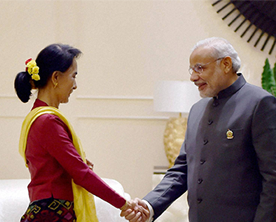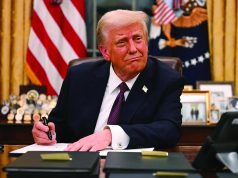Myanmar stands at the threshold of development today, seeking capital, technical and financial know how, educational resources and all the skills needed to build a strong economy. Modernization, and integration of adoption of the latest technologies, is the biggest need-of outdated systems and practices, policies and procedures. For a country that is rich in natural resources, it is imperative that they are utilized optimally to raise the living standards of the common man and improve the general quality of life. It makes perfect sense for Myanmar to solicit the aid, support and expertise of neighbouring countries that have moved ahead and have the requisite resources to help.
Commonalities between India and Myanmar
Myanmar and India share a lot in common, from colonial rule under the British, to ethnic, religious, cultural and even culinary similarities. The countries share a 1643-km long border spread along 4 north east Indian states, with connectivity set to improve as the 3200 km trilateral highway stretching from Moreh in India to Mae Sot in Thailand via Mandalay, Myanmar nears completion. Countries sharing land borders and sea routes are advantageously placed in deriving the maximum benefits from investments and economic engagement.
Mutual Benefits for both countries
India is currently pursuing a “Look East” policy as a strategy to increase connectivity, improve security cooperation, and increase its investments in infrastructure and trade with its Southeastern neighbors. Myanmar is one such neighbour that India can invest in and participate in its modernization and economic growth and in return India would get a more secure and stable neighbour. Foreign direct investment is one of the principal pillars of globalization that infuses not just large amounts of capital, but also technology, connections for marketing, managerial expertise, and opportunities.
India is Myanmar’s fifth largest trading partner; albeit with more imports into India from Myanmar than exports to the latter. Statistics revealed by the Indian embassy calculate the trade value to be $2 billion USD in FY 2014-15. Efforts have to be made to increase exports to Myanmar in the wide range of finished goods, equipment and machinery that India manufactures. The Export-Import Bank of India can play a role in promoting a balance between exports and imports.
India will be at a tremendous advantage if it invests in Myanmar, a country which is accessible and in close proximity by land and over shared waters of the Bay of Bengal. In fact, Myanmar’s ports and land corridors will give India direct access to other ASEAN countries. India is already developing the Sittwe Harbour in Rakhine State as part of a transport project and this will provide greater opportunities for trade. Myanmar’s 100-day old democratically elected government is formulating investor friendly policies as it seeks foreign participation in the power sector, infrastructure development, hotels and tourism, education and skill development, mining and technology, among others. Its favourable disposition towards India and seeking Indian expertise for its economic development is a big plus and worth taking advantage of. It helps that the leader of the winning NLD, Aung San Suu Kyi, has strong Indian connections, having studied at the prestigious Lady Sriram College, Delhi, and is favourably inclined towards seeking Indian expertise and assistance in her country’s development. The country’s 60 million people offer a ready market for the latest goods and services even as the wave of consumerism sweeps the nation. Spending power is improving and there is a distinct preference for imported products as fashions and trends change. This is a trend that’s likely to stay as better education and skills will mean greater earning, and hence spendingability. The retail sector lags behind neighbouring countries and offers big opportunities for multi brand outlets, shopping malls and international chains. At a time when generating demand and increasing sales is a challenge for most developed and developing countries, Myanmar offers promise which can increase sales and hence profits for most businesses since the demand is waiting to be tapped.
India and its leading business houses can take advantage of the interest and direction shown by PM Modi and Nirmala Sitharaman, the Minister of Commerce and Industry. Mr Modi on his visits to Myanmar has reaffirmed India’s role as a reliable partner in the development of its neighbour, Myanmar. Ms Sitharaman has listed segments like power and renewable energy, fisheries and livestock, pulses and timber trade, education and skill building, engineering and information technology, healthcare, textiles, automobiles, hospitality and tourism, banking and finance, and construction sector. With high levels of expertise in these sectors, Indian companies can use their knowledge and experience to develop them in Myanmar as well, for mutual benefit.
Myanmar has ample rich natural resources, favourable climate, fertile soil and abundant water resources, but lacks the requisite capital and technological expertise to use them for rapid growth and development. It is here that countries like India can step in, bringing in the technology and the expertise that will have a long term impact on Myanmar and its people. Indian pharmaceutical companies have already captured a sizeable chunk of the pharma market. Lack of world class healthcare facilities, an exodus towards Thailand and Singapore for treatment indicates the need for investing in state-of-the-at healthcare facilities, which leading Indian hospitals can explore, or offer opportunities for medical tourism to India. Some of India’s top hospitals like Apollo, Max Healthcare, Fortis, Medanta and Escorts Heart Institute offer the best medical treatment at a fraction of the expense incurred in Singapore and even Thailand. India offers the advantage of highly skilled and qualified doctors, whose expertise come from the large number of patients they examine every day, which enhances their diagnostic sense.
In the banking sector, the State Bank of India has become the first Indian Bank to win a license to commence operations in Myanmar and will soon be opening its first branch in Yangon. The bank can become the channel for investments and assist Indian companies establish their presence in Myanmar.
India can help in education and skill building The Indian education system has nurtured some of the brightest minds in various fields who lead top global companies and also spearhead research in America and Europe. The vast network of schoolsand institutions of higher learning have lessons for Myanmar and it is in this field that India can invest in Myanmar and foster skill development while raising literacy rates and preparing the workforce to meet international standards. As a first step, the Myanmar Institute of Information Technology at Mandalay, has been set up as a joint initiative of the governments of India and Myanmar, with the former providing financial and technical assistance, with technical support and faculty training coming from the International Institute of Information Technology at Bangalore, India. Similar institution will contribute significantly towards skill development while also providing faculty that is abreast of the latest research in their respective fields.
Myanmar’s labour is highly affordable with minimum permissible wage rate of $ 2.8 per day. This will help reduce labour costs while also generating employment for locals who can be trained to meet requirements. This will also help improve the quality of life of the common man and raise living standards. Foreign investment has always been seen as the catalyst for economic growth and positive change. A twopronged approach adopted by businesses helps yield short term profits through trading and investments in key projects will help reap long term returns. Passive policies and idle rhetoric are futile till ground realities change and an inflow of funds is seen. India needs to now move beyond discussions and policy formulations and actually initiate the investment process in Myanmar.










